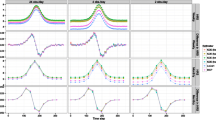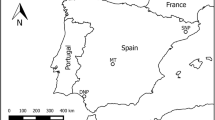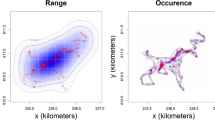Abstract
Many conclusions about mammalian ranging behaviour have been drawn based on minimum convex polygon (MCP) estimates of home range size, although several studies have revealed its unpredictable nature compared to that of the kernel density estimator. We investigated to what extent the choice of home range estimator affected the biological interpretation in comparative studies. We found no discrepancy when the question asked covered a wide range of taxa, as real and very large differences in range size were likely to have masked smaller differences due to the choice of home range estimator. However, when the question asked concerned within-species characteristics, the choice of home range estimator explained as much of the variation in range size as did the ecological variable in question. The implications for macro-ecological and intraspecific studies are discussed.

Similar content being viewed by others
References
Barg JJ, Jones J, Robertson RJ (2005) Describing breeding territories of migratory passerines: suggestions for sampling, choice of estimator, and delineation of core areas. J Anim Ecol 74:139–149
Blundell GM, Maier JAK, Debevec EM (2001) Linear home ranges: effects of smoothing, sample size, and autocorrelation on kernel estimates. Ecol Monogr 71:469–489
Borger L, Franconi N, De Michele G, Gantz A, Meschi F, Manica A, Lovari S, Coulson T (2006a) Effects of sampling regime on the mean and variance of home range size estimates. J Anim Ecol 75:1493–1405
Borger L, Franconi N, Ferretti F, Meschi F, De Michele G, Gantz A, Coulson T (2006b) An integrated approach to identify spatiotemporal and individual-level determinants of animal home range size. Am Nat 168:471–485
Gautestad AO, Mysterud I (1995) The home range ghost. Oikos 74:195–204
Getz WE, Fortmann-Roe S, Cross PC, Lyons AJ, Ryan SJ, Wilmers CC (2007) LoCoH: nonparametric kernel methods for constructing home ranges and utilization distributions. PLoS ONE 2:e207
Gompper E, Gittleman JL (1991) Home range scaling: intraspecific and comparative trends. Oecologia 87:343–348
Grigione MM, Beier P, Hopkins RA, Neal D, Padley WD, Schonewald CM, Johnson ML (2002) Ecological and allometric determinants of home-range size for mountain lions (Puma concolor). Anim Conserv 5:317–324
Harestad A, Bunnell F (1979) Home range and body weight—a reevaluation. Ecology 60:389–402
Herfindal I, Linnell JDC, Odden J, Nilsen EB, Andersen R (2005) Prey density, environmental productivity and home-range size in the Eurasian lynx (Lynx lynx). J Zool 265:63–71
Ives AR, Zhu J (2006) Statistics for correlated data: Phylogenies, space, and time. Ecol Appl 16:20–32
Jetz W, Carbone C, Fulford J, Brown JH (2004) The scaling of animal space use. Science 306:266–268
Kelt DA, Van Vuren DH (2001) The ecology and macroecology of mammalian home range area. Am Nat 157:637–645
Millspaugh JJ, Nielson RM, McDonald L, Marzluff JM, Gitzen RA, Ritenhouse CD, Hubbard MW, Sheriff SL (2006) Analysis of resource selection using utilization distributions. J Wildl Manage 70:384–395
Mysterud A, Perez-Barberia FJ, Gordon IJ (2001) The effect of season, sex and feeding style on home range area versus body mass scaling in temperate ruminants. Oecologia 127:30–39
Nilsen EB, Linnell JDC (2006) Intra-specific variation and taxa-sampling affects the home range body mass relationship. Acta Theriol 51:225–232
Nilsen EB, Herfindal I, Linnell JDC (2005) Can intra-specific variation in carnivore home-range size be explained using remote-sensing estimates of environmental productivity? Ecoscience 12:68–75
Pinheiro JC, Bates DM (2000) Mixed-effects models in S and S-Plus. Springer, New York
Schmidt-Nielsen K (1984) Scaling: why is animal size so important? Cambridge University Press, Cambridge
Seaman DE, Powell RA (1996) An evaluation of the accuracy of kernel density estimators for home range analysis. Ecology 77:2075–2085
Silva M, Downing JA (1995) CRC handbook of mammalian body masses. CRC, Boca Raton
Skrondal A, Rabe-Hesketh S (2004) Generalized latent variable modeling: multilevel, longitudinal and structural equation models. Chapman & Hall/CRC, Washington, DC
St-Pierre NR (2001) Invited review: integrating quantitative findings from multiple studies using mixed model methodology. J Dairy Sci 84:741–755
Tufto J, Andersen R, Linnell J (1996) Habitat use and ecological correlates of home range size in a small cervid: the roe deer. J Anim Ecol 65:715–724
Worton BJ (1987) A review of models of home range for animal movement. Ecol Modell 38:277–298
Acknowledgements
The authors are grateful to the Norwegian Institute for Nature Research, Hedmark University College, The Research Council of Norway and the Norwegian Directorate for Nature Management for funding this study. Jos Milner, Tim Coulson and one anonymous referee provided valuable comments on a previous draft.
Author information
Authors and Affiliations
Corresponding author
About this article
Cite this article
Nilsen, E.B., Pedersen, S. & Linnell, J.D.C. Can minimum convex polygon home ranges be used to draw biologically meaningful conclusions?. Ecol Res 23, 635–639 (2008). https://doi.org/10.1007/s11284-007-0421-9
Received:
Accepted:
Published:
Issue Date:
DOI: https://doi.org/10.1007/s11284-007-0421-9




